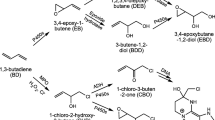Summary
Styrene exposure of 18 workers in fiber-glass reinforced plastic industries was measured for 30-min periods throughout each workday for a week. The styrene uptake was estimated using pulmonary ventilation measurements. All urine voidings were collected separately and the styrene metabolites, mandelic acid (MA) and phenylglyoxylic acid (PGA) were determined. The relationship between both exposure and uptake versus excretion of these metabolites was studied. Styrene metabolite concentrations and excretion rates (with 95% tolerance limits) were calculated to correspond to a constant 8-h exposure at the Swedish exposure limit level (25 ppm) or an uptake of an exposure limit related styrene dose (6.3 mmol). The tightest tolerance limits were obtained for excretion rate of MA + PGA per 24 h. The calculated biological exposure limit was 3.4 (± 0.7) mmol MA + PGA/24 h for a dose of 6.3 mmol styrene.
Similar content being viewed by others
References
Bardodej Z, Bardodejova E (1971) Biotransformation of ethyl benzene, styrene, and alpha-methylstyrene in man. Am Ind Hyg Assoc J 31:206–209
Droz PO, Guillemin MP (1983) Human styrene exposure. V. Development of a model for biological monitoring. Int Arch Occup Environ Health 53:19–36
Engström K (1984) 10 Styrene. In: Aitio A, Riihimäki V, Vainio H (Eds) Biological monitoring and surveillance of workers exposed to chemicals. Hemisphere Publishing Corporation, Washington New York London
Guillemin MP, Bauer D, Martin B, Marazzi A (1982) Human exposure to styrene. IV. Industrial hygiene investigations and biological monitoring in the polyester industry. Int Arch Occup Environ Health 51:139–150
Harkonen H, Kalliokoski P, Hietala S, Hernberg S (1974) Concentrations of mandelic and phenylglyoxylic acid in urine as indicators of styrene exposure. Work Environ Health 11:162–169
Lowry L (1986) Biological exposure index as a complement to the TLV. J Occup Med 28:578–582
Löf A, Lundgren E, Nydahl E-M, Byfalt Nordqvist M (1986) Biological monitoring of styrene metabolites in blood. Scand J Work Environ Health 12:70–74
Ramsey JC, Young JD, Karbowski RJ, Chenoweth MB, McCarty LP, Braun WH (1980) Pharmacokinetics of inhaled styrene in human volunteers. Toxicol Appl Pharmacol 53:54–63
Sollenberg J, Baldesten A (1977) Isotachophoretic analysis of mandelic acid, phenylglyoxylic acid, hippuric acid and methylhippuric acid in urine after occupational exposure to styrene, toluene and/or xylene. J Chromatogr 132:469–476
Sollenberg J, Smallwood AW, Lowry LK (1985) Determination of mandelic and phenylglyoxylic acids in rat urine by high-performance liquid chromatography and by isotachophoresis. J Chromatogr 343:175–178
Vesterberg O, Sollenberg J, Wrangskog K (1985) Evaluation of determinations made in urine samples. Adjustments of mandelic acid concentration using creatinine and density. Ann Am Conf Ind Hyg, vol 12, 301–304
Wigaeus E, Löf A, Byfält Nordqvist M (1984) Uptake, distribution, metabolism and elimination of styrene in man. A comparison between single exposure and co-exposure with acetone. Br J Ind Med 41:539–546
Wilson HK, Robertson SM, Waldron HA, Gompertz D (1983) Effect of alcohol on the kinetics of mandelic acid excretion in volunteers exposed to styrene vapour. Br J Ind Med 40:75–80
Zschiesche W, Schaller KH, Gossler K (1978) Quantitative determination of hippuric, phenylglyoxylic and mandelic acid in urine of styrene-exposed persons by isotachophoresis. Fresenius Z Anal Chem 290:115
Övrum P (1986) The sampling of organic solvent vapors in air by motor-powered syringes. Am Ind Hyg Assoc J 47:650–654
(1983) Criteria for a recommended standard. Occupational exposure to styrene. US Department of Health and Human Services (NIOSH) publication No. 83-119
(1986) Styrene. In: Documentation of the biological exposure indices. American Conference of Governmental Industrial Hygienists Inc., Cincinnati
(1986) Styrol. In: Henschler D, Lehnert G (Eds) Biologische Arbeitsstoff-Toleranz-Werte (BAT-Werte) Verlag Chemie, Weinheim
Author information
Authors and Affiliations
Rights and permissions
About this article
Cite this article
Sollenberg, J., Bjurström, R., Wrangskog, K. et al. Biological exposure limits estimated from relations between occupational styrene exposure during a workweek and excretion of mandelic and phenylglyoxylic acids in urine. Int. Arch Occup Environ Heath 60, 365–370 (1988). https://doi.org/10.1007/BF00405672
Received:
Accepted:
Issue Date:
DOI: https://doi.org/10.1007/BF00405672




